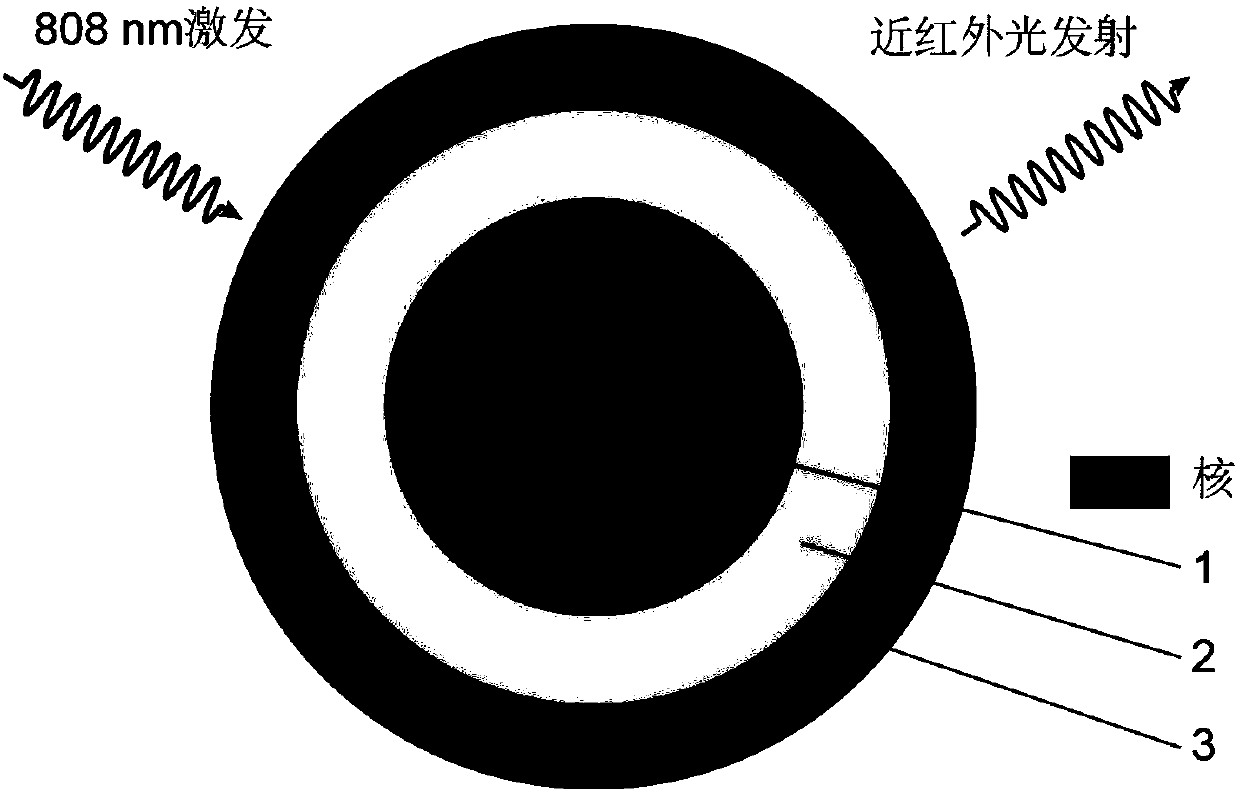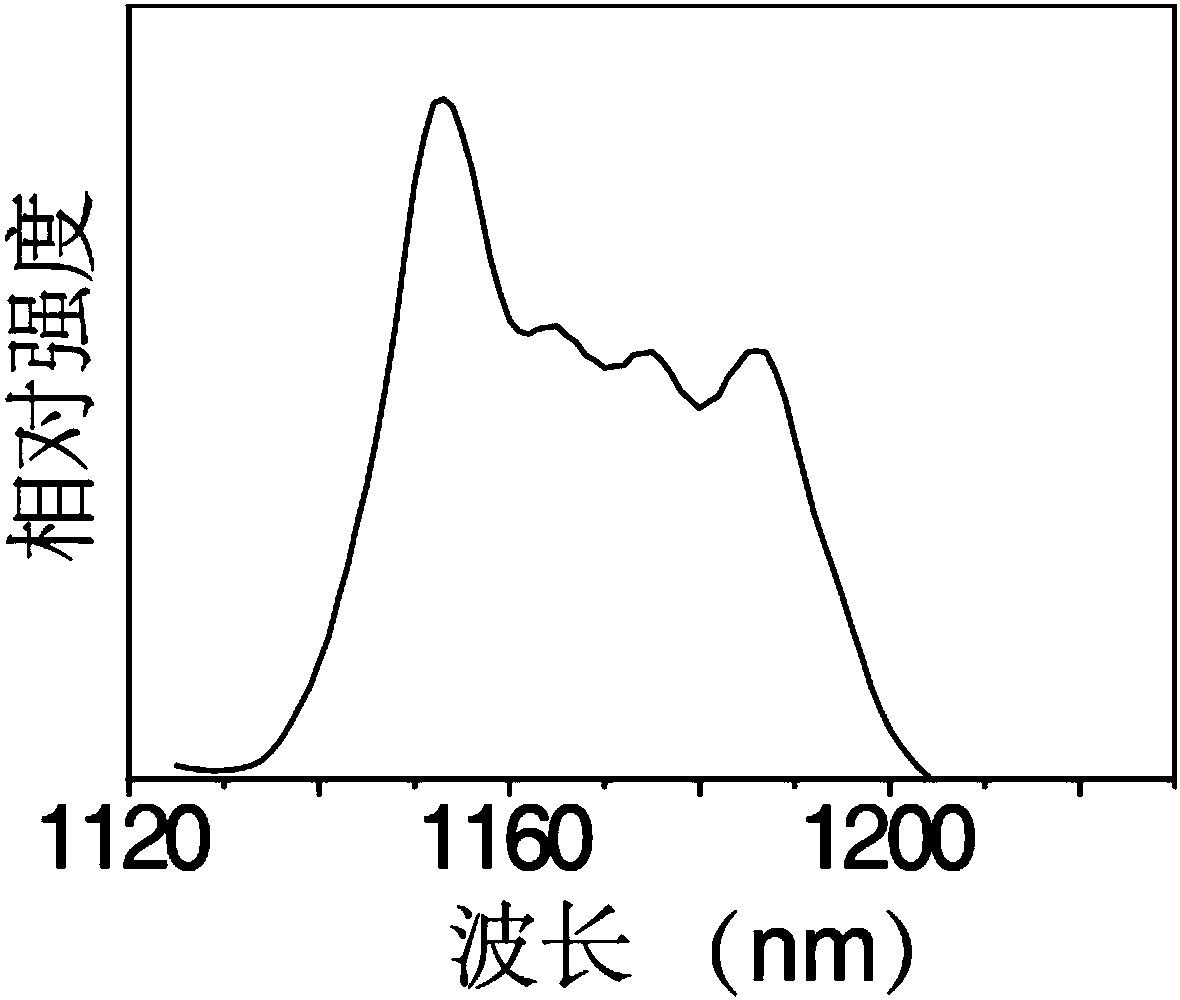Near-infrared second window emission down-conversion nanometer fluorescence probe and synthesis method thereof
A nano-fluorescence probe and near-infrared technology, which is applied in the direction of luminescent materials, fluorescence/phosphorescence, chemical instruments and methods, etc., can solve the problems of the difference in emission efficiency of rare earth ions, the difference between absorption cross section and energy level matching, and improve the sensitivity As well as the effect of accuracy and broad application prospects
- Summary
- Abstract
- Description
- Claims
- Application Information
AI Technical Summary
Problems solved by technology
Method used
Image
Examples
Embodiment 1
[0033] NaGdF 4 @NaYbF 4 :Ho(15%)@NaYF 4 :Yb(10%)@NaNdF 4 : Preparation of Yb(10%) down-conversion nanocrystals with 1155 nm emission in the second near-infrared window. Specific steps are as follows:
[0034] (1) Preparation of the shell precursor. Preparation of Gd-OA (0.1 M) precursor: Take a 100 mL three-necked round-bottomed flask as a reaction vessel, add 2.5 mmol GdCl 3 , 10 mL oleic acid (OA), 15 mL octadecene (ODE). Heating to 140 °C for 1 h under vacuum and magnetic stirring conditions finally yielded a clear and transparent Gd-OA (0.1 M) precursor.
[0035] Preparation of Yb, Ho-OA (0.1 M) precursor: Take a 50 mL three-neck round bottom flask as the reaction vessel, add 2.5 mmol ReCl 3 (Re: 85% Yb, 15% Ho), 10 mL oleic acid (OA), 15 mL octadecene (ODE). Heating to 140 °C under vacuum and magnetic stirring conditions and maintaining for 1 hour, the clear and transparent Gd, Yb, Er-OA (0.1M) precursors were finally obtained.
[0036] Preparation of Y, Yb-OA (...
Embodiment 2
[0049] NaGdF 4 @NaGdF 4 :Yb / Er(18 / 2 %)@NaYF 4 :Yb(10%)@NaNdF 4 : Preparation of Yb(10%) down-converting nanocrystals with 1525 nm emission in the second near-infrared window. Specific steps are as follows:
[0050] (1) Preparation of the shell precursor. Preparation of Gd-OA (0.1 M) precursor: Take a 100 mL three-necked round-bottomed flask as a reaction vessel, add 2.5 mmol GdCl 3 , 10 mL oleic acid (OA), 15 mL octadecene (ODE). Heating to 140 °C for 1 h under vacuum and magnetic stirring conditions finally yielded a clear and transparent Gd-OA (0.1 M) precursor.
[0051] Preparation of Gd, Yb, Er-OA (0.1 M) precursors: Take a 50 mL three-necked round-bottomed flask as a reaction vessel, add 2.5 mmol ReCl 3 (Re: 80% Gd, 18% Yb, 2% Er), 10 mL oleic acid (OA), 15 mL octadecene (ODE). Heating to 140 °C for 1 hour under vacuum and magnetic stirring conditions, finally obtained clear and transparent Gd, Yb, Er-OA (0.1 M) precursors.
[0052] Preparation of Y, Yb-OA (0.1...
PUM
| Property | Measurement | Unit |
|---|---|---|
| thickness | aaaaa | aaaaa |
| thickness | aaaaa | aaaaa |
| thickness | aaaaa | aaaaa |
Abstract
Description
Claims
Application Information
 Login to View More
Login to View More - R&D
- Intellectual Property
- Life Sciences
- Materials
- Tech Scout
- Unparalleled Data Quality
- Higher Quality Content
- 60% Fewer Hallucinations
Browse by: Latest US Patents, China's latest patents, Technical Efficacy Thesaurus, Application Domain, Technology Topic, Popular Technical Reports.
© 2025 PatSnap. All rights reserved.Legal|Privacy policy|Modern Slavery Act Transparency Statement|Sitemap|About US| Contact US: help@patsnap.com



